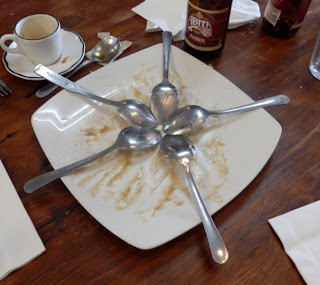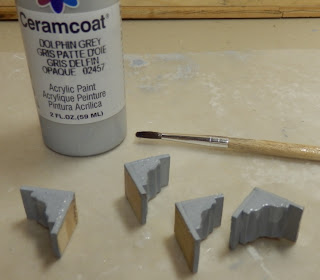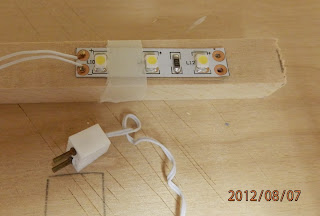The past several days have seen my hair get thinner as I wrestled with getting the lights on in the quilt shop. There are only four connections that have to work: front beam, back beam, lamp, and outside lights. In an effort to keep costs down, I'm trying to use materials I have on hand. There was a power strip in the box of electrical components that I thought I could use.
The first photo shows the components. The transformer is plugged into the extension cord. The power strip is attached to the transformer. The little plugs get plugged into the power strip. The glass tubes are fuses, one in play and a spare taped to the strip. Apparently the power strip is old enough that the insides are a bit corroded. In any event, each light element worked fine if I pressed the plug into the socket, but when I let go, it either flickered, dimmed, or went out altogether.
This is the first time I tried using a power strip. I recall that a friend who has a large dollhouse rigged this way generally has to wiggle some plugs when she lights it up for viewing. I'm thinking that unless the new power strips are a whole lot better, this isn't the optimum way to go.
So, on to Plan B, one I've used successfully before. Here are the supplies, which I also found in the electrical component box.
And this is how they work. The cord with the on/off switch is connected to the transformer and plugged into the junction splice. The junction splice is hammered into one end of the tape strip. The tape strip has a sticky back to hold it in place. I cut a piece long enough to accommodate the four lights without crowding. The tester is a handy gadget. When the power is on and its sharp prongs pierce the blue and copper strips, it completes a connection and lights up, announcing that current is flowing nicely.

Because I planned to solder the connections, I used a very sharp eXacto knife and cut away bits of the protective plastic, one on the blue strip and one on the copper strip, for each light element. I used a needle nosed pliers to grip a tiny brass brad, which was pushed halfway into the wood. The plugs were removed from the lights and more of the covering was removed, so that there would be adequate bare wire to wrap around the brad to make the connection. The wire was wrapped, being careful not to let the wires touch (one reason for the offset), and the brad was pushed in the rest of the way to secure the connection.
I started with the front beam (at the left) and worked my way toward the end of the tape. After making each connection, I tested by turning the power on. When the light went on and the tester indicated there was power beyond the element just added, I knew all was well and to go on to the next element. You'll notice an extra flap cut out of the plastic just to the left of the back beam light. The wood beneath it was so hard that I could not push the brad in securely. Rather than risk tearing up the tape, I cut a second opening that worked just fine.
In this photo, the brads are wrapped and soldered. The wires are lightly held in place with masking tape. I don't expect they'll get wiggled very much, but it's a precautionary measure.
And now, what you've been waiting for:
lights on! I like the effect. It sends a soft light through the room without being glaring. The only problem I see is that the lights on the back beam create window shadows on the background picture. Definitely not realistic. I suppose I could add another unit of LED lights outside, but I'm afraid it will be so bright out that it will appear the sun has exploded. I'm pondering a solution--maybe a very sheer curtain? Or it may be that once the room is filled, it won't be as noticeable. (The new view through the window is the Marshall, Missouri, courthouse, being auditioned for the role. Not sure this will be the final choice.)
Speaking of lights, as I was installing the outside light, I pulled away the foil that had been glued behind the original light bulb and was shocked to see the scorch marks. Scary to think what might have happened.
After the mini electricians left for the day, I stained some channel molding with the same Minwax Early American used on the floor. It will be attached to the front of the box to accept a Plexiglas panel to protect from dust and inquisitive visitors.
I was going to put a picture frame over the channel, but I think I'd prefer it to be very simple. The question now is how to handle the outside of the box. I'm being pressured to shingle the upper part like a mansard roof and do a mural showing the outside of a decaying brick building, but I've been slow to warm to that idea. It won't look like a building, because it isn't. And there are access doors that ... well,
awkward is the word that comes to mind.
I see this more as a geode -- a rough exterior with a jewel shining inside -- am am leaning toward painting it all one color. I wish there were a selection of "make it invisible" shades!
Sorry this ran on so long. I'll try to keep up a little better after this!


















































